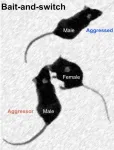(Press-News.org) The North Texas Genome Center (NTGC) at UT Arlington is getting an upgrade in the form of a next-generation genetic sequencer that will allow researchers to study genetic links between health and disease at a large scale. The new $1 million instrument, the only one of its kind in North Texas, will allow faculty and students to more deeply analyze rare genetic variants, an important step in discovering new insights for the future of health care.
“I’m excited to be able to expand and upgrade the technological capabilities of the North Texas Genome Center, a collaborative venture between UTA and other universities, medical centers and corporate partners,” said Kate C. Miller, vice president for research and innovation at UT Arlington. “The NTGC was a leader during the early days of the COVID-19 outbreak. This new equipment will allow our scientists to further advance their research in genomics at reduced cost, compared to the past.”
Called next-generation sequencing, this new technology will allow for additional DNA sequencing to discover new variants and better understand genome regulation.
“This addition to the NTGC will be a great asset for UTA’s science researchers, particularly our faculty and students who have active genome research on many topics ranging from cancer biology and antibiotic-resistant tuberculosis to diseases killing coral reefs and snake bite treatments,” said Morteza G. Khaledi, dean of the College of Science.
The upgrade to the University’s core genome lab facility is especially welcome now, as UTA’s is undertaking a faculty recruiting initiative, RISE 100, to hire 100 tenure-track faculty, 20 to 25 non-tenure-track research faculty and 40 postdoctoral researchers. The new faculty will amplify the impact of research at UTA as well as improve the undergraduate experience and enhance graduate education.
“This technology will be another asset for our top bioengineering faculty and students,” said Peter Crouch, dean of the College of Engineering. “Some of the ongoing research we have now aims to understand damaging brain swelling in newborns and improve imaging tools to track problematic heart cells. The addition of this new genetic sequencer will be a great resource for investigators.”
Founded in 2018, the NTGC is dedicated to using technology to help researchers better understand how genetic variations can lead to faster disease diagnoses, improved treatment outcomes and, ultimately, lower costs for health providers and patients.
“UTA’s College of Nursing and Health Innovation’s research integrates expertise of CONHI faculty with disciplinary expertise in nursing, kinesiology, public health, engineering and informatics, often incorporating interdisciplinary collaborations with other departments at UTA and researchers at other universities,” said Elizabeth Merwin, dean of CONHI.
“Our extensive research ranges from basic sciences to clinical care to population health across the continuum of health and the health condition, with contributions spanning bone and muscle health, cardiovascular disease, health disparities, patient outcomes, exercise science and other health related areas,” Dr. Merwin added. “The new gene sequencer will advance clinical translational sciences research, facilitate the integration of precision medicine into more research studies and enhance interdisciplinary research.”
About The University of Texas at Arlington (UTA)
Located in the heart of the Dallas-Fort Worth Metroplex, The University of Texas at Arlington is a comprehensive teaching, research, and public service institution dedicated to the advancement of knowledge through scholarship and creative work. With an enrollment of approximately 41,000 students, UT Arlington is the second-largest institution in the UT System. UTA’s combination of outstanding academics and innovative research contributes to its designation as a Carnegie R-1 “Very High Research Activity” institution, a significant milestone of excellence. The University is designated as a Hispanic Serving-Institution and an Asian American Native American Pacific Islander-Serving Institution by the U.S. Department of Education and has earned the Seal of Excelencia for its commitment to accelerating Latino student success. The University ranks as the No. 1 national public university in the U.S. for veterans (Military Times, 2024), No. 4 in Texas for advancing social mobility (U.S. News & World Report, 2025), and No. 6 in the United States for its undergraduate ethnic diversity (U.S. News & World Report, 2025). UT Arlington’s approximately 270,000 alumni occupy leadership positions at many of the 21 Fortune 500 companies headquartered in North Texas and contribute to the University’s $28.8 billion annual economic impact on Texas.
END
UTA invests in cutting-edge genomic research technology
$1 million gene sequencer is the only one of its kind in North Texas
2024-10-15
ELSE PRESS RELEASES FROM THIS DATE:
Male mice use female mice to distract aggressors and avoid conflict
2024-10-15
A research group led by Joshua Neunuebel at the University of Delaware, USA, tracked the behavior of mice using machine learning to understand how they handle aggressive behavior from other mice. The researchers’ findings, published on October 15th in the open-access journal PLOS Biology, show that male mice deescalate aggressive encounters by running over to a female mouse to distract the aggressive male mouse.
The researchers recorded groups of two male and two female mice interacting over five hours. Like many other animals, mice have social hierarchies, and in almost each group recorded, one male was always significantly more aggressive towards the other.
Social interactions ...
19th century French psychiatrists: Unsung heroes of modern melancholia research
2024-10-15
In an era where mental health awareness is at the forefront of public discourse, a new historical review is shedding light on the often-overlooked French contributions to our understanding of depression. Published in Genomic Psychiatry, the study by Dr. Kenneth S. Kendler and Virginia Justis of Virginia Commonwealth University examines a seminal 1897 French monograph that helped shape modern concepts of melancholia and depression.
The review focuses on "La Mélancolie" by Jacques Roubinovitch ...
Fighting the opioid epidemic: AI and optimization model leads to more accessible, equitable treatment resource distribution
2024-10-15
New Study Key Takeaways:
New model focuses on more equity and accessibility in opioid overdose treatment locations and resource allocation.
Utilizing this model, the results project that within 2 years, there will be a decrease in the number of people with opioid use disorder, an increase in the number of people getting treatment and a decrease in opioid-related deaths.
Policymakers should target adding treatment facilities to counties that have significantly fewer facilities than their population share and are more socially vulnerable.
BALTIMORE, MD, October 15, 2024 – The opioid epidemic is a crisis that has plagued the United States for decades. ...
2 million voters with felony convictions have the right to vote – but might not know
2024-10-15
Key takeaways
Voting eligibility for people with felony convictions has expanded since 1997, with more than two million individuals now able to vote.
Several factors, like misinformation, distrust of government or lack of clarity around procedures, impede many from exercising their right to vote.
Direct outreach, including through trusted, on-the-ground community organizations, as well as informational text messaging, can help eligible voters navigate the process and make sure their voices are included in elections.
As get-out-the-vote efforts hit high gear nationwide, a team of sociologists, political scientists ...
Alzheimer’s disease may damage the brain in two phases
2024-10-15
Alzheimer’s disease may damage the brain in two distinct phases, based on new research funded by the National Institutes of Health (NIH) using sophisticated brain mapping tools. According to researchers who discovered this new view, the first, early phase happens slowly and silently — before people experience memory problems — harming just a few vulnerable cell types. In contrast, the second, late phase causes damage that is more widely destructive and coincides with the appearance of symptoms and the rapid ...
Enhanced wavelength conversion to advance quantum information networks
2024-10-15
Advancements in quantum information technology are paving the way for faster and more efficient data transfer. A key challenge has been ensuring that qubits, the fundamental units of quantum information, can be transferred between different wavelengths without losing their essential properties, such as coherence and entanglement. As reported in Advanced Photonics, researchers from Shanghai Jiao Tong University (SJTU) recently made significant strides in this area by developing a novel method for broadband frequency conversion, a crucial step for future quantum networks.
The SJTU team focused on a technique using X-cut thin film lithium niobate ...
Aston University researchers to explore using AI and fibre-optic networks to monitor natural hazards and infrastructures
2024-10-15
Aston University is leading a new £5.5 million EU research project
Will focus on converting fibre-optic cables into sensors to detect natural hazards
Could identify earthquakes and tsunamis and assess civil infrastructure.
Aston University is leading a new £5.5 million EU research project to explore converting existing telecommunication fibre-optic cables into sensors which can detect natural hazards, such as earthquakes and tsunamis, and assess the condition of civil infrastructure.
The project is called ECSTATIC (Engineering Combined Sensing and Telecommunications Architectures for Tectonic and Infrastructure Characterisation) ...
Testing and evaluation of health care applications of large language models
2024-10-15
About The Study: Existing evaluations of large language models mostly focus on accuracy of question answering for medical examinations, without consideration of real patient care data. Dimensions such as fairness, bias, and toxicity and deployment considerations received limited attention. Future evaluations should adopt standardized applications and metrics, use clinical data, and broaden focus to include a wider range of tasks and specialties.
Corresponding Author: To contact the corresponding author, Nigam H. Shah, MBBS, PhD, email nigam@stanford.edu.
To ...
FDA perspective on the regulation of AI in health care and biomedicine
2024-10-15
About The Study: Strong oversight by the U.S. Food and Drug Administration (FDA) protects the long-term success of industries by focusing on evaluation to advance regulated technologies that improve health. The FDA will continue to play a central role in ensuring safe, effective, and trustworthy AI tools to improve the lives of patients and clinicians alike. However, all involved entities will need to attend to AI with the rigor this transformative technology merits.
Corresponding Author: To contact the corresponding author, Haider J. Warraich, MD, email haider.warraich@fda.hhs.gov.
To ...
Arthropods dominate plant litter decomposition in drylands
2024-10-15
Researchers have shown that larger insects such as woodlice and beetles play as much of a crucial role in leaf litter decomposition across different habitats and seasons as microbes and smaller invertebrates.
The research, published today as a final Version of Record after previously appearing as a Reviewed Preprint in eLife, was described by editors as a fundamental study that substantially advances our understanding of the role of different-sized soil invertebrates in shaping the rates of leaf litter decomposition. The authors provide compelling evidence that the summed effects of all decomposers on decomposition rates, with large-sized invertebrates being ...
LAST 30 PRESS RELEASES:
Why nail-biting, procrastination and other self-sabotaging behaviors are rooted in survival instincts
Regional variations in mechanical properties of porcine leptomeninges
Artificial empathy in therapy and healthcare: advancements in interpersonal interaction technologies
Why some brains switch gears more efficiently than others
UVA’s Jundong Li wins ICDM’S 2025 Tao Li Award for data mining, machine learning
UVA’s low-power, high-performance computer power player Mircea Stan earns National Academy of Inventors fellowship
Not playing by the rules: USU researcher explores filamentous algae dynamics in rivers
Do our body clocks influence our risk of dementia?
Anthropologists offer new evidence of bipedalism in long-debated fossil discovery
Safer receipt paper from wood
Dosage-sensitive genes suggest no whole-genome duplications in ancestral angiosperm
First ancient human herpesvirus genomes document their deep history with humans
Why Some Bacteria Survive Antibiotics and How to Stop Them - New study reveals that bacteria can survive antibiotic treatment through two fundamentally different “shutdown modes”
UCLA study links scar healing to dangerous placenta condition
CHANGE-seq-BE finds off-target changes in the genome from base editors
The Journal of Nuclear Medicine Ahead-of-Print Tip Sheet: January 2, 2026
Delayed or absent first dose of measles, mumps, and rubella vaccination
Trends in US preterm birth rates by household income and race and ethnicity
Study identifies potential biomarker linked to progression and brain inflammation in multiple sclerosis
Many mothers in Norway do not show up for postnatal check-ups
Researchers want to find out why quick clay is so unstable
Superradiant spins show teamwork at the quantum scale
Cleveland Clinic Research links tumor bacteria to immunotherapy resistance in head and neck cancer
First Editorial of 2026: Resisting AI slop
Joint ground- and space-based observations reveal Saturn-mass rogue planet
Inheritable genetic variant offers protection against blood cancer risk and progression
Pigs settled Pacific islands alongside early human voyagers
A Coral reef’s daily pulse reshapes microbes in surrounding waters
EAST Tokamak experiments exceed plasma density limit, offering new approach to fusion ignition
Groundbreaking discovery reveals Africa’s oldest cremation pyre and complex ritual practices
[Press-News.org] UTA invests in cutting-edge genomic research technology$1 million gene sequencer is the only one of its kind in North Texas







